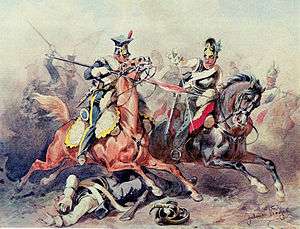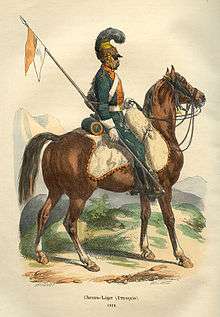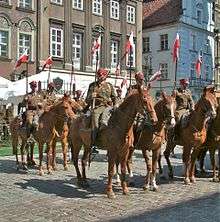Lancer

A lancer was a type of cavalryman who fought with a lance. Lances were used in mounted warfare by the Assyrians as early as 700 BC and subsequently by Greek, Persian, Gallic, Han-Chinese, nomadic and Roman horsemen.[1] The weapon was widely used in Asia and Europe during the Middle Ages and the Renaissance by armoured cavalry, before being adopted by light cavalry, particularly in Eastern Europe. In a modern context, a lancer regiment usually denotes an armoured regiment.
17th–19th century
The lancer (called ułan in Polish and Ulan in German) had become a common sight in almost every European, Ottoman and Indian army during this time, but, with the exception of the Ottoman troops, they increasingly discarded the heavy armour to give greater freedom of movement in combat. The Polish "winged" lancers were amongst the last to abandon the armour in Europe. There was a widespread debate over the value of the lance in mounted combat during the 18th and 19th centuries and most armies had few lancer units by the beginning of the 19th century; however, during the Napoleonic Wars, lancers were to be seen in many of the combatant nations as their qualities became clear. During the wars, the Poles became a ready territory for recruitment by several armies, willingly or unwillingly, and served with distinction in most of these armies, most famously in Napoleon's French Imperial Guard as the 1er Regiment de Chevau-Legers-Lanciers de la Garde Impériale.

At the Battle of Waterloo, French lances were "nearly three meters (about nine feet, ten inches) long, weighed three kilograms (about six pounds, ten ounces), and had a steel point on a wooden staff," according to historian Alessandro Barbero. He adds that they were "terrifyingly efficient." Commander of the French 1st Corps, 4th Division General Durutte, who saw the battle from the high ground in front of Papelotte, would write later, "I had never before realized the great superiority of the lance over the sword."[2]
In the Siege of Los Angeles (1846), during the war between Mexico and the United States, a company of Californio lancers temporarily recaptured the town, expelling a company of U.S. Marines.
Although the lance had its greatest impact in the charge, lancers were vulnerable against other cavalry, as the lance proved a clumsy and ineffective weapon (compared to the sabre) at close quarters.[3] By the late 19th century, many cavalry regiments in the British and other European armies were composed of troopers with lances (as well as sabres or other secondary weapons) in the front rank and men with sabres in the second; the lances for the initial shock and sabres for the mêlée.
Lancer's equipage

Lancers typically wore a double-breasted jacket (kurtka) with a coloured panel (plastron) at the front, a coloured sash, and a square-topped Polish cap (czapka). Their lances usually had small swallow-tailed flags (known as the lance pennon) just below the spearhead. The pennons were normally removed or wrapped in a canvas cover on active service. With the improved range and accuracy of infantry rifles, the high-profile presented by lancers with their conspicuous weapons became a problem. The ułans or uhlans, as lancers are known in the Polish and German languages respectively, were trained to lower their lances when scouting on hill-tops.
20th century lancers
In 1914, lances were still being carried by regiments in the British, Indian, French, German, Italian, Portuguese, Spanish, Japanese, Turkish, Belgian and Russian armies, amongst others. Almost all German cavalry (hussars, dragoons and cuirassiers as well as uhlans) retained a steel lance as their primary weapon.[4] As late as 1914, half of the troopers in each Russian regular cavalry regiment (hussars, uhlans and dragoons) carried lances on active service, as did all cossacks.[5]
The British lancer regiments lost this weapon for all but ceremonial use following the Boer War, but a conservative backlash led to its reintroduction for active service from 1908 to 1928.[Note 1] The French army did not have lancer regiments as such, but steel lances 2.97 metres in length were carried by the twenty-six dragoon regiments and some light cavalry units in 1914. The French had earlier tested the Indian bamboo lances used by the British cavalry, but had rated them as being too fragile for the shock of encounter.[6]
Prior to the outbreak of World War I, there had been controversy as to whether lances or sabres were the more effective "armes blanches" (that is edged weapons) for cavalry, but neither proved a match for modern firearms. Some armies continued to use lances throughout this war, but they seldom saw use on the Western Front after initial clashes in France and Belgium in 1914. On the Eastern Front, mounted cavalry still had a role and lances saw limited use by the Russian, German and Austrian armies.[7]
During the 1920s, the use of lances ceased for active service in most armies. British and Indian lancer regiments continued to carry lances on mounted parades, until mechanization took place in the late 1930s. Some other armies retained lance armed ceremonial units. The Polish cavalry did not discard the lance as a weapon until 1934 and continued to train with lances until the outbreak of World War II.[8]
Current lancer units

Some modern armored cavalry units are still designated as lancer regiments for historical reasons. There are examples in the armies of Spain (the King's Lancers), United Kingdom (Royal Lancers), India (2nd Lancers (Gardner's Horse) and 20th Lancers), Belgium, Portugal (2nd Lancers Regiment), Pakistan, Italy (5th Lancieri di Novara, 6th Lancieri di Aosta, 8th Lancieri di Montebello) and Australia (12th/16th Hunter River Lancers, 1st/15th Royal New South Wales Lancers), Argentina (2nd Tank Cavalry Regiment "General Paz's Lancers", Argentine Army) and Chile (5th Cavalry Regiment "Lancers", Chilean Army). The elite troops of the Colombian National Army are called "lanceros". The Italian Lancieri di Montebello (8th Cavalry Regiment) occasionally parade honor guards and other dismounted ceremonial detachments in the regiment's nineteenth century blue uniforms, armed with the lances carried until 1920. Although not classified as lancers, the Brazilian Army's Dragões da Independência (1st Guards Regiment) and the Portuguese National Republican Guard's horse squadrons carry lances on mounted parades, as do ceremonial cavalry regiments in Chile, Argentina, Bolivia and Peru.
See also
Notes
- ↑ For an illustration of a fully armed lancer, see Chappell's "Men at Arms Series British Cavalry Equipment 1800–1941" illustration G 1.
References
- ↑ Niels M. Saxtorph: "Warriors & Weapons of Early Times" ISBN 0-7137-0575-2.
- ↑ Barbero, pp. 161, 163.
- ↑ p150, Volume 16, Encyclopaedia Britannica, Eleventh Edition
- ↑ John Terraine, page 68, "Mons. Retreat to Victory", 1960, ISBN 978-0713411638
- ↑ Nick Cornish, page 5 "The Russian Army 1914-18, ISBN 1-84176-303-9
- ↑ Christian Tollet "Les Dragons 1914" Histoire & Collections 2009
- ↑ Vladimir Littauer, pages 115-116, "Russian Hussar", ISBN 1-59048-256-5
- ↑ Steven J. Zaloga "The Polish Army 1939-45" ISBN 0-85045-417-4
Sources
- Barbero, Alessandro, The Battle; A New History of Waterloo, Walker & Co., New York 2005,
- Chappell, Mike (2002). Men at Arms Series British Cavalry Equipment 1800-1941. Men–at–arms No. 138 (revised ed.). Oxford: Osprey Publishing. OCLC 48783714.
